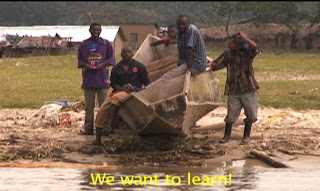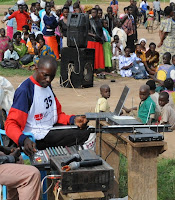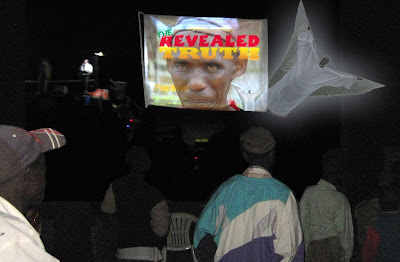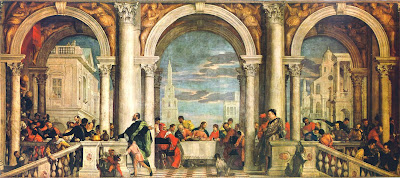During my last week in Uganda a traveling evangelical crusade camped out in the playground across the street from my house. All of Kiwangala, from my neighbors to the motorcycle-taxi guys, came out to see the preachers. It was free entertainment for a population that lives off of a dollar a day. Uganda is strongly Christian. In fact, a year earlier in the very same playground, a network of village churches called The Shepherd’s Fellowship performed a passion play on the life of Jesus Christ. It was titled The Revealed Truth. The pastors asked me to videotape the event. The night pictured above was the premier of the film I edited together. I gave a DVD to the traveling crusade and they projected the movie, drive-in style, on a large sheet. Among the audience were the actors of the film watching themselves, most seeing themselves for the first time on video, in the field where they had acted.
Back in America, I was leafing through my old Art History 101 textbook and found Veronese’s Feast in the House of Levi. He painted this for some nuns whose copy of Titian’s Last Supper was burned in a fire. Last Suppers were a popular theme at the time and Veronese whipped them up a new one.
What makes this painting unique are its small details. Veronese painted dwarves, Huns, dogs, a cat, a man with a bloody nose, and drunks breaking bread at Christ’s final meal. The hall of the banquet looks out on a Venetian piazza.
It was enough to get Veronese summoned by the Inquisition. Veronese quickly repented, changed the title from The Last Supper to Feast in the House of Levi, and thus ushered in a secular age of art.
The Revealed Truth is a little like the Feast of Levi. It contains elements of the modern world that gives away the date and place of performance and creates a snapshot of Sub-Saharan Africa in 2009. The film becomes a zeitgeist by inadvertently documenting the available technology and belief systems that dominated the community at the time. Often, the most interesting parts of the movie are not the miracles of Jesus, but the villagers who are watching the play unfold.

Kiwangala, Masaka is in the heart of the Buganda tribal kingdom and its people are mostly subsistence farmers and fishermen. Their lifestyle is in many ways more similar to the characters of Biblical times than those of the developed world. They relate to the parables of Jesus quite literally. Jesus’ story of the farmer who sowed seed in different types of soil is not just an allegory of church building, but good agricultural advice. Even the title of President Musevini’s autobiography borrows from the parable of the mustard seed. Agriculture and fishing is not just the occupation of most Ugandans, but the core of the country’s identity and how it has embraced Christianity.
A Note on the Soundtrack and Some History of the Production
 The film’s soundtrack made this one of the most challenging and time-involved movies I’ve worked on. The play is performed in Luganda, the local language. The pastors’ plan was to record the actors before the performance. The actor’s were supposed to lip-sync to the recording as it played over a PA system. I recorded the players in a kind of radio theater reading of the play with the Garage Band program and my laptop’s internal microphone. The audio came out great, but was a complete disaster when it was performed because the speakers had to compete with the blaring of the electric generator. The actors ended up pantomiming. It took me the better part of a year to re-sync the soundtrack back to the video and then go back and add the subtitles. However, I learned a lot about Luganda from the experience.
The film’s soundtrack made this one of the most challenging and time-involved movies I’ve worked on. The play is performed in Luganda, the local language. The pastors’ plan was to record the actors before the performance. The actor’s were supposed to lip-sync to the recording as it played over a PA system. I recorded the players in a kind of radio theater reading of the play with the Garage Band program and my laptop’s internal microphone. The audio came out great, but was a complete disaster when it was performed because the speakers had to compete with the blaring of the electric generator. The actors ended up pantomiming. It took me the better part of a year to re-sync the soundtrack back to the video and then go back and add the subtitles. However, I learned a lot about Luganda from the experience.
The music is an eclectic group of tracks that I collected in large part from the guys who sold bootleg mix tapes around the Masaka and Kampala taxi parks. The film includes traditional, religious, classical, pop, R&B music from Uganda, East Africa, and beyond. A local DJ’s CD intended for weddings, graduations, birthdays, and discos provides the movie’s sound effects.
The Revealed Truth Blog Series
This post is the first of a nine part series that takes an in-depth  look at the The Revealed Truth and how rural Ugandan culture influenced the making of the film. The movie is about an hour long but I’ve broken it down into 5 to 10 minute blog-size episodes. The next post will feature the nativity and Jesus meeting the fishermen.
look at the The Revealed Truth and how rural Ugandan culture influenced the making of the film. The movie is about an hour long but I’ve broken it down into 5 to 10 minute blog-size episodes. The next post will feature the nativity and Jesus meeting the fishermen.



